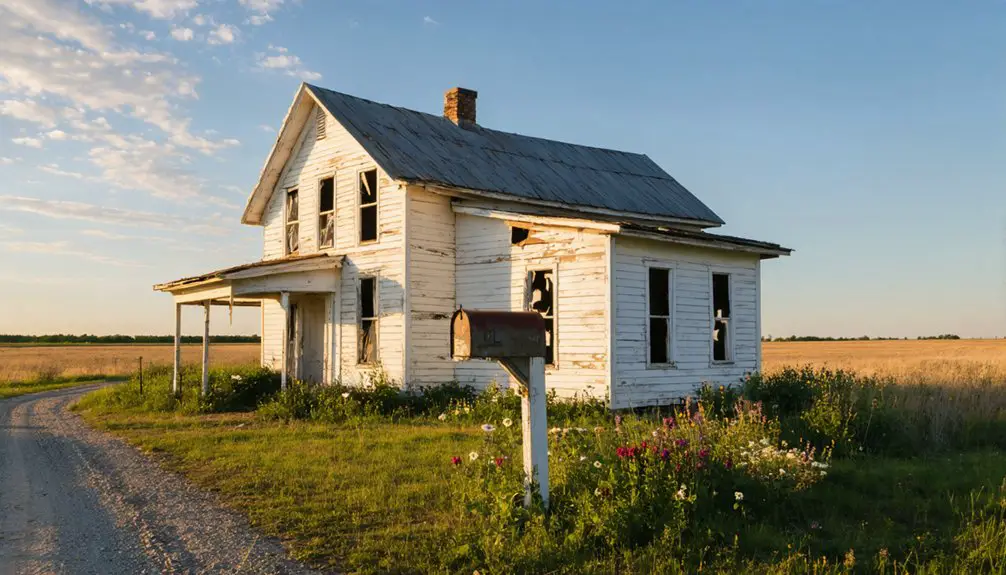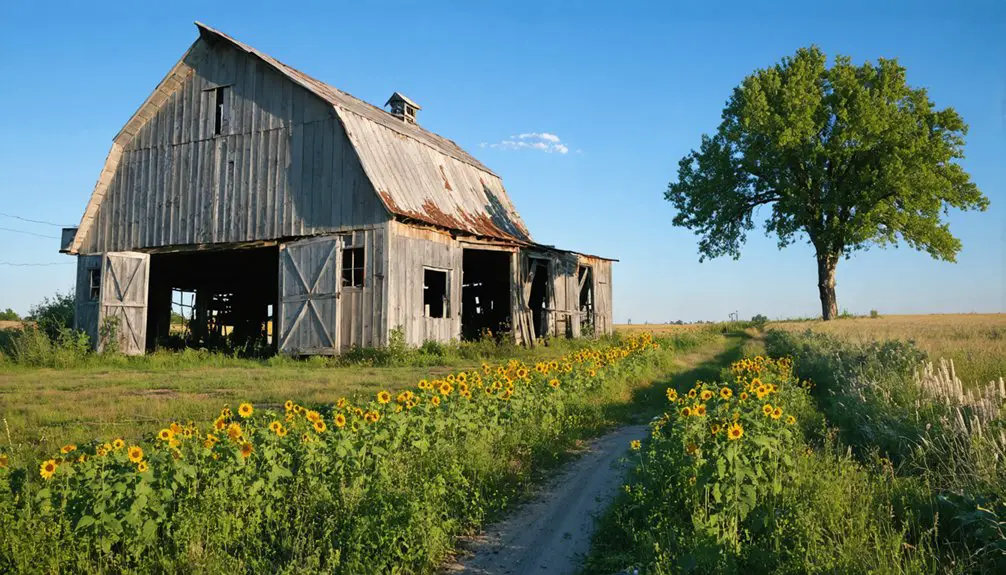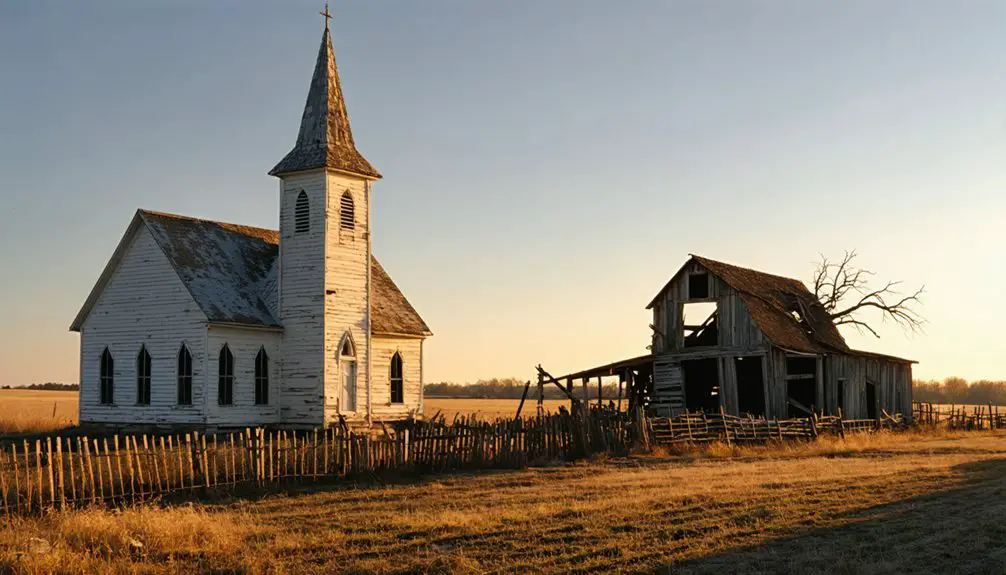You’ll find Homedahl’s remnants in southwestern Seely Township, Minnesota, where Scandinavian settlers once built a thriving farming community in the 1850s. The settlement centered around its post office, Lutheran churches, and strong cultural traditions. When railroad routes bypassed the town, residents gradually moved to nearby Bricelyn for better transportation access. While nature has reclaimed most of the original settlement, Homedahl’s story echoes through Minnesota’s rich immigrant heritage.
Key Takeaways
- Homedahl was a Scandinavian settlement in southwestern Seely Township, Minnesota, established in the 1850s by Swedish and Norwegian immigrants.
- The community thrived around its post office, which served as a vital hub for mail services and community connectivity.
- Being bypassed by essential railroad routes led to Homedahl’s economic decline, causing residents to relocate to nearby trading centers.
- The financial panic of 1857 accelerated Homedahl’s downfall, resulting in business closures and the loss of postal routes.
- Today, Homedahl exists as a ghost town, with its former site reclaimed by agricultural activities and natural vegetation.
While Minnesota’s Scandinavian settlement began in earnest during the 1850s, the foundations for Homedahl’s establishment were laid by early Swedish and Norwegian pioneers who sought farmland in the state’s fertile regions.
Following the Treaty of Traverse des Sioux in 1851, Scandinavian migration patterns reflected a strong desire to maintain cultural ties, with settlers often clustering in ethnic enclaves that mirrored their homeland villages.
You’ll find that these communities, anchored by Lutheran churches, preserved their native languages and customs well into the 20th century.
Settlement patterns typically followed existing Indigenous pathways and trading routes, particularly along river valleys, where immigrants could access land through newly established legal processes. The St. Croix River served as a vital transportation corridor for both Native Americans and early traders in the region.
The promise of available farmland and economic opportunity drew waves of Scandinavians escaping hardship in their homeland. The Pre-emption Act of 1841 enabled these immigrants to claim government land before it went up for public sale.
Life in Early Homedahl
Life in early Homedahl centered around farming and strong community bonds that grew from the Scandinavian settlers’ shared heritage.
Pioneer resilience shone through as families adapted to Minnesota’s harsh climate, building homes from local timber and sod while establishing productive farmstads. Agricultural adaptation meant cultivating crops suited to northern conditions and raising livestock for sustenance and labor. Early settlers obtained their plots through land grant programs that provided opportunities for ownership. Settlers faced persistent economic challenges during the 1857 depression, with many struggling to maintain their land claims while experiencing poor crop yields.
- Lutheran churches served as the heart of community life, hosting both religious services and social gatherings.
- Settlers constructed log cabins and frame houses, later upgrading to more permanent structures.
- Families relied on nearby mills for grain processing and small stores for essential supplies.
- Waterways and primitive roads provided crucial connections to outside markets.
- Home remedies and traveling doctors filled the gap in medical care during isolated times.
The Post Office Era
During the late 19th and early 20th centuries, Homedahl’s post office stood as an essential community hub in southwestern Seely Township, Faribault County. You’d find locals gathering there regularly, as the postal service facility handled crucial mail and parcels while fostering community connectivity through face-to-face interactions. Like Minnesota’s early mail services that operated on horseback and foot, rural communities relied heavily on these basic but vital delivery methods. Most residents used P.O. boxes for their private mail collection, a common practice of the era.
Beyond its role in communication, the post office strengthened Homedahl’s economic foundations by processing business correspondence and shipping needs. It wasn’t just a government outpost – it represented local autonomy and served as a cornerstone of rural life alongside the town’s school and store.
When broader postal service consolidation swept through the region, Homedahl’s facility merged with larger nearby towns, marking a significant turning point. This closure symbolized the community’s gradual decline toward its eventual ghost town status.
Cultural Heritage and Community
Beyond the post office’s role as a community anchor, Homedahl’s rich Scandinavian heritage shaped every aspect of local life.
You’ll find that settlers created a vibrant social fabric through their shared customs, language, and religious practices. Lutheran churches and mutual aid societies formed the backbone of community celebrations, while traditional food, folk music, and seasonal gatherings strengthened cultural bonds. Like many towns across the region, Homedahl eventually became a ghost town as resources depleted and populations shifted. Similar to historical markers found at other abandoned Minnesota settlements, commemorative signs now tell the story of this once-thriving community.
- Community gatherings at general stores and schools fostered lasting relationships
- Lutheran church services preserved religious and linguistic traditions
- Social traditions included cooperative work projects and festivals
- Local education emphasized Scandinavian values and practical skills
- Inter-family networks sustained the town’s close-knit character
These cultural touchstones didn’t just define Homedahl’s identity – they created a resilient community that valued self-sufficiency and mutual support, even as economic challenges emerged.
The Path to Decline
Despite early promise and strong cultural foundations, Homedahl’s decline began when essential railroad routes bypassed the settlement in favor of other locations.
You would’ve seen the town’s liveliness drain away as the lack of railroad connectivity cut off crucial trade routes and transportation options, leading to severe economic stagnation.
Many settlers and businesses relocated to nearby trading centers, mirroring the exodus seen in other failed settlements of the era.
The financial panic of 1857 dealt another crushing blow to Homedahl’s survival chances.
Like the town of Ignatius Donnelly’s Nininger, economic struggles intensified as eastern banks collapsed, credit disappeared, and speculative land values plummeted.
You’d have witnessed local businesses shuttering their doors while residents moved away to towns with rail depots.
The loss of postal routes and commercial activity further isolated the community, creating a downward spiral.
Without economic diversification and the key railroad connection, Homedahl couldn’t sustain itself, ultimately joining the ranks of Minnesota’s ghost towns.
Absorption Into Bricelyn
The final chapter of Homedahl’s story began in 1899 when the Southern Minnesota and Northern Iowa Townsite Company purchased 160 acres of farmland from the dwindling settlement.
In 1899, Homedahl’s decline accelerated as the railroad company acquired farmland, signaling the settlement’s eventual absorption into Bricelyn.
As Bricelyn emerged as a railroad hub, you’ll find that Homedahl’s identity quickly merged into its growing neighbor through urban development and demographic shifts.
Key changes that sealed Homedahl’s fate:
- Railroad expansion drew businesses and residents to Bricelyn’s center
- The Bricelyn Farmers Elevator Company took control of agricultural trade points
- Former Homedahl businesses relocated to the new commercial district
- Population concentrated in Bricelyn for better transportation access
- Community functions integrated into Bricelyn’s social and political framework
Legacy in Minnesota’s Rural History

You’ll find Homedahl’s transformation from thriving Scandinavian settlement to ghost town mirrors countless other rural Minnesota communities that faced similar economic and demographic shifts in the early 1900s.
The town’s absorption into nearby Bricelyn demonstrates how larger agricultural centers gradually consumed smaller farming settlements, reshaping the rural landscape through consolidation.
While Homedahl’s physical presence has largely vanished, its cultural legacy endures through preserved immigrant histories, genealogical records, and the broader story of Scandinavian influence in Minnesota’s development.
Lost Rural Settlement Patterns
Throughout Minnesota’s rural history, settlement patterns reveal a complex story of boom-and-bust cycles driven by changing transportation networks, resource economies, and demographic shifts.
You’ll find that rural economy transformations often determined whether a community thrived or vanished, with transportation access playing a vital role.
- Railroad routes could make or break a town’s survival chances
- Resource-based settlements rose and fell with mining or agriculture
- Communities often centered around essential services like post offices
- Multiple churches and schools marked peak settlement periods
- Natural reclamation eventually consumed abandoned structures
Looking at settlement patterns across Minnesota’s landscape, you’ll notice how closely tied a town’s fate was to its economic foundations.
When industries shifted or transportation routes changed, communities either adapted or gradually disappeared, leaving behind cemeteries and deteriorating buildings as silent witnesses to their existence.
Cultural Heritage Preservation Impact
While physical traces of Homedahl may have faded, its cultural heritage continues to shape Minnesota’s rural identity. You’ll find its legacy preserved through artifacts, photographs, and oral histories that document early Scandinavian settlement patterns.
These resources now serve as valuable tools for heritage education and cultural tourism initiatives throughout the region.
The town’s story enriches local museums and historical programs, offering insights into immigrant life and community adaptation. You can explore Homedahl’s impact through archaeological findings that reveal domestic life and trade patterns of early rural Minnesota.
Its preservation alongside other ghost towns like Elcor helps illustrate the broader narrative of industrial change and rural development. Through these elements, you’re connecting with an essential piece of Minnesota’s immigrant heritage and pioneer spirit.
Post-Ghost Town Land Transformation
After Homedahl’s decline, its lands underwent a significant transformation as agricultural activities reclaimed the former town site. The land reclamation process reflected a common pattern among Minnesota’s ghost towns, where nature and farming gradually erased traces of human settlement.
- Former town structures gave way to productive cropland and pastures.
- Natural vegetation reclaimed areas, returning some spots to pre-settlement conditions.
- Soil profiles retained subtle hints of past human habitation.
- Agricultural evolution reshaped property boundaries while preserving original town layouts.
- Local drainage patterns and ecosystems adapted to the site’s new rural character.
You’ll find that Homedahl’s transformation mirrors the broader story of rural Minnesota, where abandoned communities often return to their agricultural roots.
This shift preserved the land’s economic value while writing a new chapter in the region’s continuing story of adaptation and change.
What Remains Today

Today, the former military base in Homedahl stands as a tribute to its Cold War past, with approximately 26 military buildings and 44 residential homes still dotting the landscape.
You’ll find single-stall garages alongside these homes, though most structures have succumbed to years of neglect and exposure to the elements.
The military remains tell a complex story, as the site’s toxic legacy from Cold War operations continues to impact soil and groundwater.
Nature has begun to reclaim the abandoned properties, with forest and brush obscuring many structures.
While the rugged terrain of Lookout Mountain and Lake Superior create a striking backdrop, the environmental challenges and hazardous conditions have deterred redevelopment, leaving Homedahl frozen in time as a reflection of its strategic military history.
Frequently Asked Questions
What Was the Peak Population of Homedahl During Its Most Prosperous Years?
You can’t find Homedahl’s exact peak population during its prosperous years, as historical records don’t preserve specific counts, though it likely reached several hundred residents during early 1900s farming expansion.
Were There Any Notable Businesses or Industries Besides the Post Office?
You’ll find local industries thrived beyond the post office, with two general stores, two hotels, a blacksmith shop, and a distillery serving the community’s needs during its historically significant period.
Did Any Original Homedahl Buildings Survive Within Modern-Day Bricelyn’s Boundaries?
You can’t definitively confirm any building preservation of original Homedahl structures within Bricelyn today, though local historical societies might hold undocumented information about their historical significance and possible survival.
You’ll find they practiced crop rotation, growing potatoes as their main cash crop, alongside wheat, rye, and oats. They’d also cultivate hay to feed livestock through Minnesota’s harsh winters.
Were There Any Churches or Schools Established During Homedahl’s Existence?
You won’t find documented church history or education legacy in historical records – there’s no evidence of established churches or schools during the community’s existence before being absorbed by Bricelyn.
References
- https://www.youtube.com/watch?v=5bCG6B2rzZY
- https://www.minnesotahistory.org/post/the-ghost-town-of-nininger-minnesota
- https://quickcountry.com/minnesota-ghost-towns/
- https://www.mngoodage.com/voices/mn-history/2019/07/a-ghost-town-turned-history-site/
- https://www.faribaultcountyregister.com/opinions/editorials/2010/03/14/some-places-in-faribault-county-to-avoid-on-a-dark-rainy-night/
- https://www.wchsmn.org/scandia/
- https://www3.mnhs.org/mnopedia/search/index/swedish-immigration-minnesota
- https://www3.mnhs.org/mnopedia/search/index/norwegian-immigration-minnesota
- https://www.stcroix360.com/2024/02/the-first-swede-part-3-st-croix-valley-swedish-settlers-into-the-unknown/
- https://www.youtube.com/watch?v=_G1PH6cXReM



